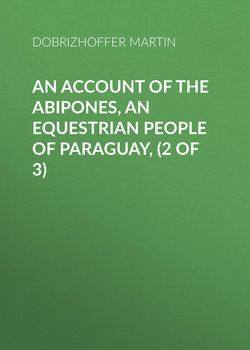Читать книгу An Account of the Abipones, an Equestrian People of Paraguay, (2 of 3) - Dobrizhoffer Martin - Страница 2
CHAPTER II.
OF THE NATURAL COLOUR OF THE AMERICANS
ОглавлениеWhen European painters have represented a man of a dark complexion, naked and hairy from head to foot, with flat distorted nostrils, threatening eyes, and a vast belly, a monster, in short, armed with a quiver, bow, arrows, and a club, and crowned with feathers of various colours, they think they have made an admirable portrait of an American Indian. And, indeed, before I saw America, I pictured the Americans to myself as agreeing with this description; but my own eyes soon convinced me of my error and I openly denounced the painters, to whom I had formerly given credit, as calumniators and romancers. Upon a near view of innumerable Indians of many nations, I could discover none of those deformities which are commonly ascribed to them. None of the Americans are black like Negroes, none so white as the Germans, English and French, but of this I am positive, that many of them are fairer than many Spaniards, Portugueze, and Italians. The Americans have whitish faces, but this whiteness, in some nations, approaches more to a pasty colour, and in others is darker; a difference occasioned by diversity of climate, manner of living, or food. For those Indians who are exposed to the sun's heat in the open plain, must necessarily be of a darker colour than those who dwell always in the shade of forests, and never behold the sun. The women are fairer than the men, because they go out of doors less frequently, and whenever they travel on horseback, take greater care of their complexions, skreening their faces with fans made of the longer emu feathers.
I have often wondered that the savage Aucas, Puelches or Patagonians, and other inhabitants of the Magellanic region, who dwell nearer to the South Pole, should be darker than the Abipones, Mocobios, Tobas, and other tribes, who live in Chaco, about ten degrees farther north, and consequently suffer more from the heat. May not the difference of food have some effect upon the complexion? The Southern savages feed principally upon the flesh of emus and horses, in which the plains abound. Does this contribute nothing to render their skin dark? What, if we say that the whiteness of the skin is destroyed by very severe cold, as well as by extreme heat? Yet if this be the case, why are the inhabitants of Terra del Fuego more than moderately white: for that island is situated in the fifty-fifth degree of latitude, at the very extremity of South America, hard by the Antarctic Pole? May we not suppose that these Southern nations derive their origin from Africa, and brought the dark colour of the Africans into America? If any one incline to this opinion, let him consider by what means they crossed the immense sea which separates Africa from America, without the use of the magnet.
Many have written, and most persons at this day believe the Patagonians to be giants, perhaps the progeny of the Cyclops Polyphemus; but believe me when I say that the first are deceivers, and the latter their dupes. In the narrative of the voyage of the Dutch commander, Oliver Von Nord, who, in the year 1598, passed the Straits of Magellan, the Patagonians are asserted to be ten or eleven feet high. The English, who passed these straits in 1764, gave them eight feet of height. The good men must have looked at those savages through a magnifying-glass, or measured them with a pole. For in the year 1766, Captains Wallis and Carteret measured the Patagonians, and declared them to be only six feet, or six feet six inches high. They were again measured in 1764, by the famous Bourgainville, who found them to be of the same height as Wallis had done. Father Thomas Falconer, many years Missionary in the Magellanic region, laughs at the idea entertained by Europeans of the gigantic stature of the Patagonians, instancing Kangapol chief Cacique of that land, who exceeded all the other Patagonians in stature, and yet did not appear to him to be above seven feet high. Soon after my arrival, I saw a great number of these savages in the city of Buenos-Ayres. I did not, indeed, measure them, but spoke to some of them by an interpreter, and though most of them were remarkably tall, yet they by no means deserved the name of giants.
